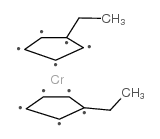55940-03-9
| Name | bis(ethylcyclopentadienyl)chromium |
|---|---|
| Synonyms |
1,1'-Diethylchromocene
MFCD01862449 |
| Density | 1.15 g/mL at 25ºC(lit.) |
|---|---|
| Molecular Formula | C14H18Cr |
| Molecular Weight | 238.28900 |
| Exact Mass | 238.08100 |
| LogP | 3.60340 |
|
Section 1: Product Identification Chemical Name:Bis(ethylcyclopentadienyl)chromium, min. 98% CAS Registry Number:55940-03-9 Formula:[(C2H5)C5H4]2Cr EINECS Number:none Chemical Family:metallocene Synonym:1,1'-Diethylchromocene
Section 2: Composition and Information on Ingredients IngredientCAS NumberPercentACGIH (TWA)OSHA (PEL) Title compound55940-03-9100%0.5mg/m3 (as Cr)0.5mg/m3 (as Cr) Section 3: Hazards Identification Irritating to eyes, skin an respiratory tract. Harmful by inhalation, in contact with skin and if swallowed. Emergency Overview: Chromium (III), a possible metabolite, has acted as a tumorigen and mutagen in animal studies. Primary Routes of Exposure:Ingestion, inhalation of dust Eye Contact:Causes slight to mild irritation of the eyes Skin Contact:Causes slight to mild irritation of the skin. Harmful in contact with skin. Inhalation:Irritating to the nose, mucous membranes and respiratory tract. Harmful through inhalation. Ingestion:Harmful if swallowed. Acute Health Affects:Irritating to skin, eyes and respiratory tract. Harmful through inhalation, in contact with skin and if swallowed. It is possible that prolonged exposure could result in formation of Chromium (III) salts in the human body. Chronic Health Affects:Although less toxic than Chromium (VI), some animal studies show Chromium (III) to act as a mutagen and tumorigen. NTP:Yes IARC:No OSHA:No SECTION 4: First Aid Measures Immediately flush the eyes with copious amounts of water for at least 10-15 minutes. A victim may need Eye Exposure: assistance in keeping their eye lids open. Get immediate medical attention. Wash the affected area with water. Remove contaminated clothes if necessary. Seek medical assistance if Skin Exposure: irritation persists. Remove the victim to fresh air. Closely monitor the victim for signs of respiratory problems, such as difficulty Inhalation: in breathing, coughing, wheezing, or pain. In such cases seek immediate medical assistance. Seek medical attention immediately. Keep the victim calm. Give the victim water (only if conscious). Induce Ingestion: vomiting only if directed by medical personnel. SECTION 5: Fire Fighting Measures Flash Point:none Autoignition Temperature:none Explosion Limits:none Extinguishing Medium:carbon dioxide, foam or dry powder If this product is involved in a fire, fire fighters should be equipped with a NIOSH approved positive pressure Special Fire Fighting Procedures: self-contained breathing apparatus and full protective clothing. Hazardous Combustion andIf involved in a fire this material may emit irritating and toxic fumes. Decomposion Products: Unusual Fire or Explosion Hazards: No unusual fire or explosion hazards. SECTION 6: Accidental Release Measures Spill and Leak Procedures:Small spills can be mixed with vermiculite or sodium carbonate and swept up. SECTION 7: Handling and Storage Store in a tightly sealed container. Handle and store under an inert atmosphere of nitrogen or argon. Handling and Storage: Exposure to air may result in degradation of the product. SECTION 8: Exposure Controls and Personal Protection Eye Protection:Always wear approved safety glasses when handling a chemical substance in the laboratory. Skin Protection:Wear protective clothing and gloves. Ventilation:If possible, handle the material in an efficient fume hood. If ventilation is not available, a respirator should be worn. The use of respirators requires a Respiratory Respirator: Protection Program to be in compliance with 29 CFR 1910.134. Ventilation:If possible, handle the material in an efficient fume hood. Additional Protection:No additional protection required. SECTION 9: Physical and Chemical Properties Color and Form:red liq. Molecular Weight:238.29 Melting Point:no data Boiling Point:95-98°C /1.0mm Vapor Pressure:no data Specific Gravity:no data Odor:none Solubility in Water:insoluble SECTION 10: Stability and Reactivity Stability:air sensitive liquid Hazardous Polymerization:none Contact with oxygen. Keep away from heat and ignition sources including open flame and electrostatic Conditions to Avoid: discharge. Incompatibility:strong oxidizing agents Decomposition Products:carbon dioxide, carbon monoxide, organic fumes and chromium oxide. SECTION 11: Toxicological Information RTECS Data:No information available from the RTECS files. Carcinogenic Effects:No data available Mutagenic Effects:No data available Tetratogenic Effects:No data available SECTION 12: Ecological Information Ecological Information:No information available SECTION 13: Disposal Considerations Disposal:Dispose of according to local, state and federal regulations. SECTION 14: Transportation Shipping Name (CFR):Self-heating liquid, Inorganic, N.O.S. Hazard Class (CFR):4.2 Additional Hazard Class (CFR):NA Packaging Group (CFR):II UN ID Number (CFR):UN# 3186 Shipping Name (IATA):Self-heating liquid, Inorganic, N.O.S. Hazard Class (IATA):4.2 Additional Hazard Class (IATA):NA Packaging Group (IATA):II UN ID Number (IATA):UN# 3186 SECTION 15: Regulatory Information TSCA:Not listed on the TSCA inventory SARA (Title 313):Title compound: see Category Code N090 for reporting Second Ingredient:none SECTION 16 - ADDITIONAL INFORMATION N/A |
| Symbol |


GHS02, GHS07 |
|---|---|
| Signal Word | Danger |
| Hazard Statements | H250-H302-H312-H315-H319-H332-H335 |
| Precautionary Statements | P222-P231-P261-P280-P305 + P351 + P338-P422 |
| Personal Protective Equipment | Eyeshields;Faceshields;full-face respirator (US);Gloves;multi-purpose combination respirator cartridge (US);type ABEK (EN14387) respirator filter |
| Hazard Codes | F,Xn |
| Risk Phrases | 17-20/21/22-36/37/38 |
| Safety Phrases | S26-S36 |
| RIDADR | UN 2845 4.2/PG 1 |
